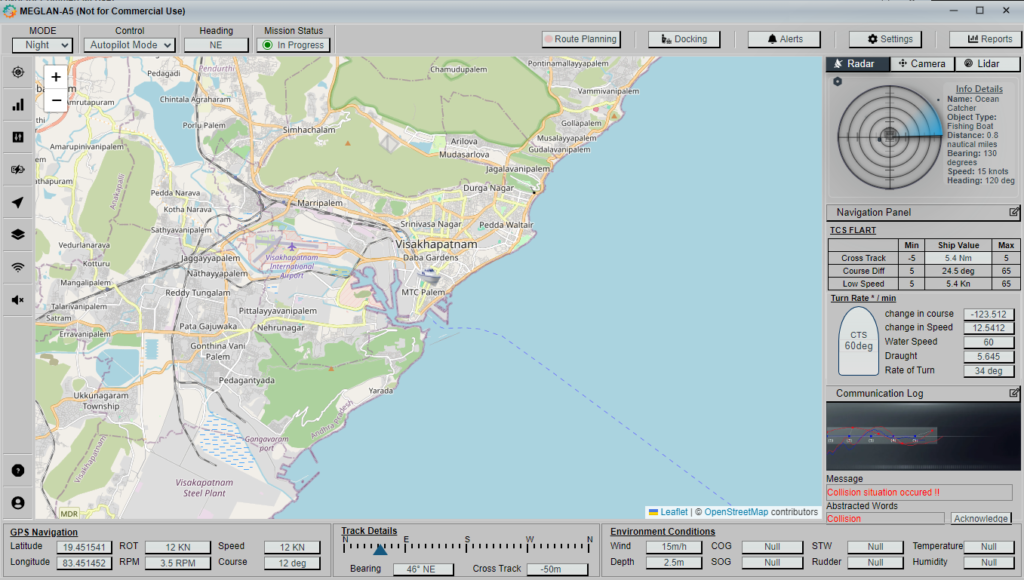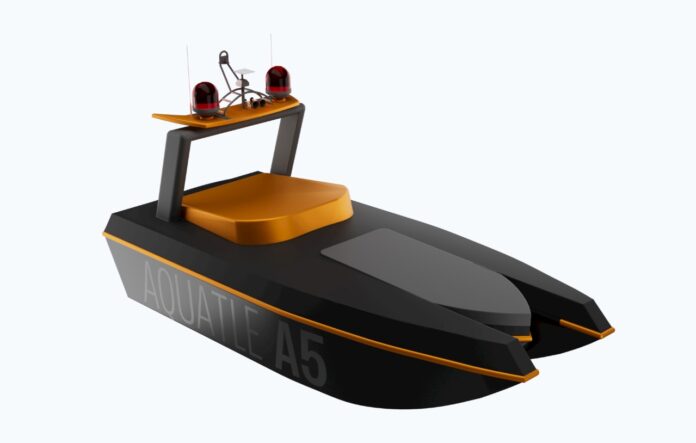By Aastha Verma

In an era of heightened geopolitical tensions and increasing demand for maritime security, autonomous surveillance vessels are emerging as pivotal assets for navies and coastguards. These advanced, unmanned vessels represent a major leap forward in maritime defence, combining innovative technologies with enhanced operational efficiencies. This article examines the evolution, capabilities, applications, challenges, and future of autonomous surveillance vessels in modern defence operations.
The Evolution of Autonomous Maritime Systems
The concept of unmanned maritime vehicles (UMVs) can be traced back to the early 20th century when remote-controlled boats were initially used for various applications. However, the true potential of autonomous surveillance vessels was only realized through recent advancements in robotics, artificial intelligence (AI), and sensor technology.
Today’s autonomous vessels are capable of independent operation or functioning as part of an integrated fleet, guided by sophisticated algorithms for navigation, obstacle avoidance, and mission fulfillment. Equipped with state-of-the-art sensors such as radar, sonar, and electro-optical/infrared (EO/IR) systems, these vessels can provide persistent and wide-ranging surveillance, significantly enhancing maritime security operations.
Capabilities of Autonomous Surveillance Vessels
- Autonomous Navigation
Autonomous vessels are equipped with GPS and inertial navigation systems, enabling independent operation without human intervention. This capability allows them to autonomously chart courses, adjust for environmental variables, and avoid hazards, even in complex maritime landscapes.
- Real-Time Data Collection
These vessels are capable of gathering large volumes of data through advanced sensors. This data, analysed in real time, provides actionable intelligence to operators, enhancing situational awareness and enabling rapid responses to dynamic scenarios.
- Persistent Monitoring
Autonomous vessels have the capability to conduct long-duration missions without the need for human crew members, allowing for continuous monitoring of high-risk areas. This persistent monitoring is invaluable for applications such as border control and surveillance of critical infrastructures.
- Cost Efficiency
By removing the need for onboard crew and reducing logistical support requirements, autonomous vessels offer substantial cost savings over traditional manned vessels. This economic advantage allows for expanded mission capabilities, from routine patrols to specialized operations, at a fraction of the cost.
- Interoperability
Autonomous vessels are designed to integrate seamlessly with other maritime and aerial assets, including aircraft and manned ships. This interoperability enables multi-domain operational synergy, which increases mission effectiveness by leveraging the strengths of various platforms.
Applications in Defence and Security
- Maritime Patrol and Surveillance
One of the primary roles of autonomous surveillance vessels is to conduct maritime patrols, monitoring shipping lanes, detecting illegal fishing activities, and identifying potential threats such as piracy and smuggling. Deploying these vessels in busy, high-risk areas provides navies with enhanced situational awareness and the ability to respond to threats quickly and efficiently.
- Border Security
Coast guard agencies around the world are increasingly relying on autonomous vessels for border security. These vessels can patrol extensive coastlines and monitor maritime boundaries with greater effectiveness than traditional methods. Equipped with advanced sensors, they can detect unauthorized crossings and relay real-time data to command centers for rapid response.

- Environmental Monitoring
Beyond security, autonomous vessels also play a crucial role in environmental monitoring. They can conduct surveys to assess marine biodiversity, monitor pollution levels, and gather data on climate change impacts. This information is critical for policy development and conservation efforts, providing insights that are essential for protecting marine ecosystems.
- Search and Rescue Operations
Autonomous vessels are highly effective in search and rescue missions. Equipped with thermal imaging and sonar systems, they can cover large areas swiftly, increasing the likelihood of locating distressed vessels or individuals. Their capacity to operate in adverse weather conditions further enhances their value in emergency response scenarios.
- Naval Warfare and Intelligence Gathering
In military applications, autonomous vessels are capable of performing intelligence, surveillance, and reconnaissance (ISR) missions. They can operate in contested environments, gathering crucial information on enemy movements without risking human lives. Additionally, they can function as decoys or support assets during naval operations, strengthening the capabilities of manned platforms.
Challenges Facing Autonomous Surveillance Vessels
- Regulatory and Legal Issues
The deployment of autonomous vessels poses complex regulatory and legal challenges. Issues such as sovereignty, maritime law, and accountability in the event of accidents or incidents require careful consideration. International collaboration is essential to develop comprehensive guidelines for the operation of these vessels.
- Cybersecurity Threats
As autonomous vessels rely heavily on digital systems, they are vulnerable to cybersecurity threats. Malicious actors could potentially hijack or disrupt the operations of these vessels, posing significant risks to maritime security. Robust cybersecurity measures are imperative to protect these assets from unauthorized interference.
- Technological Limitations
Despite technological advancements, autonomous vessels still face operational challenges. Factors like adverse weather conditions, ocean currents, and underwater terrain can impact their performance. Continued development in sensor technology, navigation systems, and AI algorithms is essential to enhance the reliability and functionality of these vessels.
- Human Oversight and Trust
While autonomous vessels are capable of operating independently, human oversight remains crucial. Gaining trust in these systems among operators and decision-makers is vital for successful integration. Training and education are necessary to ensure personnel can work effectively alongside autonomous systems, fostering a collaborative human-AI environment.
Future Prospects of Autonomous Surveillance Vessels
- Increased Autonomy
Advances in decision-making algorithms will enable future autonomous vessels to undertake more complex missions with minimal human intervention. Enhanced autonomy allows for real-time adaptability in dynamic maritime environments, increasing operational flexibility.
- Swarm Technology
Swarm technology, where multiple autonomous vessels operate collaboratively toward a shared objective, is becoming more feasible. Swarm systems can cover larger areas, share data in real time, and conduct coordinated operations against a range of maritime threats.
- Enhanced Sensor Fusion
Developments in sensor fusion will allow autonomous vessels to integrate data from multiple sources, enhancing situational awareness and decision-making. This capability will improve threat detection and response times, making autonomous vessels more effective in diverse maritime scenarios.
- Greater Interoperability
As the use of autonomous vessels grows, the need for interoperability with existing naval and Coast Guard assets will increase. Future systems will likely incorporate standardized communication protocols, enabling seamless integration in joint operations and maximizing mission effectiveness.
- Expanded Applications
Beyond defence and security, autonomous surveillance vessels will find applications in commercial industries, scientific research, and environmental protection. This versatility makes them valuable tools for a wide range of maritime contexts, broadening their impact beyond traditional military operations.
Spotlight on Innovation: Aquatle A5 – Meglan, a Game-Changer in Autonomous Surveillance
Developed by Tardid, the Aquatle A5 – Meglan is a groundbreaking autonomous surface vessel designed for surveillance and security missions. Tardid has been a leader in artificial intelligence technology for heavy industries, focusing on maritime, defence, manufacturing, and oil & gas since 2017. The Aquatle A5 leverages Tardid’s proprietary Brainbox AI platform, enabling it to “see, hear, and understand” its surroundings, effectively securing maritime zones.
Distinctive Features of Aquatle A5 – Meglan
- AI-Powered Autonomy
Unlike conventional remotely operated vessels (ROVs), the Aquatle A5 utilizes Brainbox AI algorithms, allowing for autonomous decision-making. This capability makes it suitable for dual-use applications across defence and commercial markets.
- Electric Propulsion
With a fully electric drive, the Aquatle A5 operates on a physics-aware AI platform, which minimizes environmental impact without sacrificing operational efficiency.
- Multi-Sensor Fusion
Integrating optical, thermal, laser, and radar technology, Aquatle A5 can detect, classify, and track maritime objects even in challenging operational environments.
- Enhanced Security Features
The vessel incorporates vein-printing technology for secure access, erasing sensitive data within seconds if unauthorized access is detected. This design minimizes the risk of data breaches and unauthorized access, enhancing operational security.
In addition to its advanced capabilities, Aquatle A5 – Meglan is cost-effective, reducing surveillance costs by nearly 50% compared to conventional surveillance vessels. Tardid also offers retrofitting options, enabling existing vessels to be equipped with autonomous functionalities.
The Role of AI Captain in Maritime Autonomy
Tardid’s AI Captain is an advanced decision intelligence system designed to serve as a digital co-pilot for ship captains. Leveraging machine learning and predictive analytics, AI Captain provides real-time strategic support for navigation and operational challenges, making it an invaluable tool in autonomous maritime operations.
Key Functionalities of AI Captain:
- Collision Avoidance and Smart Routing
AI Captain uses real-time data from sensors, radar, and AIS (Automatic Identification System) to analyze the vessel’s surroundings. It dynamically adjusts the vessel’s route to prevent collisions, even in high-traffic areas.
- Friend & Foe Analysis
This feature provides situational awareness by assessing the intents of nearby vessels and differentiating between allies, neutrals, and potential threats. AI Captain continuously monitors traffic patterns and vessel behaviors, helping crews make informed decisions.
- Predictive Maintenance and Health Monitoring
AI Captain monitors the vessel’s systems, predicting potential mechanical issues before they arise. This proactive approach to maintenance ensures peak operational readiness and minimizes the risk of disruptions.
- Smart Incident and Risk Assessment
AI Captain assesses unforeseen scenarios such as equipment malfunctions or piracy risks, recommending optimal responses based on real-time data. This capability provides critical support during high-stakes situations, helping crews remain prepared and agile.
- Proactive Fuel and Energy Optimization
By analyzing real-time oceanographic and meteorological data, AI Captain optimizes fuel consumption and emission levels, supporting sustainable maritime operations.
- Autonomous Surveillance Coordination
In scenarios involving multiple vessels, AI Captain enables coordinated manoeuvres, optimizing surveillance patterns to maximize coverage. This function is particularly useful in border security and territorial defence operations.
Conclusion
Autonomous surveillance vessels are rapidly transforming maritime security, providing enhanced capabilities in surveillance, data gathering, and operational support. With ongoing advancements in AI, sensor fusion, and swarm technology, these vessels will play a crucial role in addressing the growing challenges of maritime security. By overcoming regulatory and technological challenges, the future of autonomous surveillance vessels promises to expand across defence, environmental, and commercial applications. As the technology evolves, the maritime industry will witness a shift toward fully autonomous, multi-mission-capable fleets, revolutionizing our approach to securing the world’s waters.
Aastha Verma, Chief Operating Officer at Tardid, is a seasoned technocrat with almost a decade of experience driving advancements in Artificial Intelligence. She has been instrumental in formulating strategies and cultivating international business opportunities.





